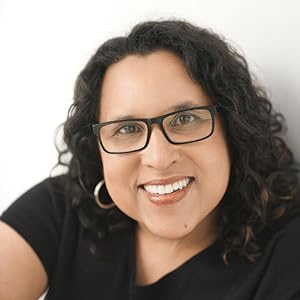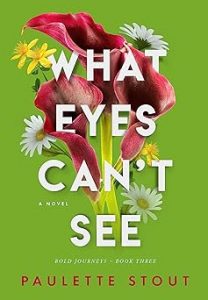How to Write Outside Your Cultural Experience Without Harm
How to Write Outside Your Cultural Experience Without Harm
By Paulette Stout
 As writers, we have great latitude when choosing what we create. And with diversity, equity, inclusion, and belonging at the forefront for many in the creative community, our instinct should rightly be to answer the call in our work. But writing outside our experience can have serious pitfalls and consequences if not done properly. By sharing my path to creating my most recent novel, What Eyes Can’t See, I hope to inspire others to address representation in their own work.
As writers, we have great latitude when choosing what we create. And with diversity, equity, inclusion, and belonging at the forefront for many in the creative community, our instinct should rightly be to answer the call in our work. But writing outside our experience can have serious pitfalls and consequences if not done properly. By sharing my path to creating my most recent novel, What Eyes Can’t See, I hope to inspire others to address representation in their own work.
Know Your Why
When striving to diversity your characters, it’s essential to be clear about your motivations and humble about your ignorance. I say this from the best-intentioned place possible. If you have no connection to a particular community, be transparent with yourself about your motivations for choosing the characters and themes to address. What’s more, identify whether you can authentically pull it off without relying on harmful stereotypes.
For example, when I undertook writing What Eyes Can’t See, I had a very clear “why.” As a bi-racial Brown woman, I wanted to see more characters like me in the women’s fiction stories I read. There’s much more diversity in romance than in women’s fiction, so my goal was to help change that. I also had been writing the Black best friend character, Barbara Washington, for two books and she frankly deserved to be a leading lady. However you choose to start, embrace the education process because you have a lot to learn and not all of it will be comfortable.
Draw on Analogous Experiences
Admittedly, navigating the world as a Brown woman gave me a baseline of understanding about my novel’s theme of otherness, belonging, and justice as experienced by a Black woman. I’ve battled otherness and belonging my entire life. This includes being the only woman of color in a room. Not being included in social activities with work colleagues. Lagging colleague’s advancement despite high achievement. Having retail staff watch me with suspicion when in stores. All these gave me a foundation from which to grow and learn when tacking the unique life experiences of Black women, which began with a hefty amount of research.
Dig Deep to Learn
Before I wrote a single word, I did research. I read books about the experiences of Black women in the workplace and in the legal profession. My main character is a lawyer, and my research showed Black women experience significant workplace discrimination because of their unique intersectionality. Knowing this, and reading the data firsthand helped me formulate key questions I explored further during one-on-one interviews.
Directly engaging with people from the community you hope to write about enables you to connect with each other human to human. Beyond getting your prepared questions answered, you can learn about their lives, hopes, concerns, and challenges. These conversations are priceless for a host of reasons. They enable you to expand your understanding and respectfully ask questions you need clarified before developing your work.
Beyond face-to-face interviews, I watched other interviews, lectures and speeches, respectfully listened in Black social spaces, and had additional conversations with Black friends and family. After all this work, I finally felt equipped to sit down and write.
Solicit Ongoing Feedback
Ordinarily, I never share first drafts. But when writing this book, I engaged with two sensitivity readers on an ongoing basis who read my manuscript in 20,000 word chunks as it progressed. This enabled me to have deep conversations about key scenes, get feedback, and revise in real time to be more culturally accurate. Having this insight enabled me to quickly address anything that needed fixing, while also identifying opportunities to advance plot and characterization in nuanced ways. The more conversations I had with these women about the book, the easier it became to craft the world of my main character.
By the third draft, I wanted to engage with another sensitivity reader to get a fresh perspective from someone not intimately involved in the drafting. This third check provided the confirmation I needed that I’d achieved my goal: an authentic story that helped Black readers feel seen on the page. At this time, I also engaged beta readers from non-marginalized backgrounds to ensure my story’s message was strong, but relatable for a wide cross-section of readers.
Be Transparent About Your Identity
When writing outside your experience, it’s essential to be transparent about who you are—and aren’t. Too often, authors get cute, trying to hide their identity. They don’t include author pictures on the back cover or interior and fail to address their background in any way (if you’ve read the book Yellowface, insert that scenario here). Being murky about your background creates mistrust with readers and can lead to a backlash later when readers learn who you are.
Avoid this quagmire by being honest about who you are from the very beginning. I recommend writing an author’s note placed in your frontmatter, which is accessible to anyone considering reading your book. It should discuss your motivations, process, and thank the sensitivity readers who helped you along the way. Beyond your frontmatter, be sure to avoid encouraging any ambiguity in your marketing, social profiles or author platform that could lead readers to believe you’re from the community portrayed if you’re not. For example, I never call my book a “black romance” or “black book” as that implies it’s written by a Black author. Know the sensitivities for the community you’re portraying so you can honor them. Failing to do so opens you up to accusations of cultural appropriation. And, it should rightly cast doubt on the purity of your motivations for pursuing representation in your work. (See know your why.)
Readers deserve books as diverse as the world around us. As a bi-racial Brown woman, I tire of reading books where people like me simply don’t exist. It makes me, my culture, and experiences feel erased. People of all backgrounds, disabilities, and gender identities make valuable contributions to the world we inhabit. Let’s infuse that vibrancy into the books we read. When seeking to right this wrong and be inclusive in the stories you create, following these steps can help ensure your contribution does more good than harm.
—
Paulette Stout is the fearless author of contemporary fiction whose books say the quiet things out loud. Her debut, Love, Only Better, is a relatable and empowering story readers are calling a “must read.” Her follow-up, What We Never Say, explores a ripped-from-the-headlines #MeToo topic with a surprising twist. Book three tackles race, class and belonging featuring two characters with sizzling chemistry.
Born in Manhattan and raised by a single dad, Paulette loves crafting stories that make readers feel and think.
You can usually find Paulette rearranging words into pleasing patterns while wearing grammar t-shirts. Either that, or texting pictures of something she’s whipped up in her kitchen to her two adult kids while her husband rolls his eyes.
Enjoy free reads on Paulette’s website at paulettestout.com/free.
Follow Paulette on Instagram: @paulettestoutauthor, Tiktok: @paulettestoutauthor, Facebook: @paulettestoutauthor Twitter: @StoutContent and on her website at paulettestout.com.
And don’t forget to leave a review after you finish reading!
What Eyes Can’t See, Paulette Stout
 Barbara’s fairytale life has hit a brick wall. Worst part, she didn’t see it coming.
Barbara’s fairytale life has hit a brick wall. Worst part, she didn’t see it coming.
Barbara navigates the NYC corporate world as a confident Black lawyer, balancing sky-high career goals with heavy family expectations. But while her career thrives at 31, her engagement crumbles, leaving her heartbroken—and stuck with a non-refundable destination wedding.
Arriving at her island paradise, Barbara is swept away by Sebastian—a hazel-eyed lawyer with a snake tattoo and a mysterious past. Their deep connection makes Barbara feel seen for the first time in her life.
For Sebastian, time stops when he’s with Barbara. It doesn’t matter that she’s rich, and he grew up on food stamps. That her clothes are designer and his hide old gang tattoos. Even that he’s white, and she’s Black. None of their differences matter until he’s handed the job meant for her.
Jobless and stripped of her family’s wealth, Barbara digs deep to find herself and her voice. Suspecting she faced racial discrimination, Barbara challenges her boss in court. It’s a decision that puts Barbara and Sebastian on opposite sides of a battle they long to fight together.
As their love and convictions are put to the test, one crucial question remains, how much are they willing to risk to find justice?
Multi-award-winning author Paulette Stout returns with a bold and spicy story of love, social justice, and belonging that’ll stay with you long after the last page. It’s fast-paced contemporary fiction for lovers of strong heroines with something to say about the world.
BUY HERE
Category: Contemporary Women Writers, How To and Tips






























